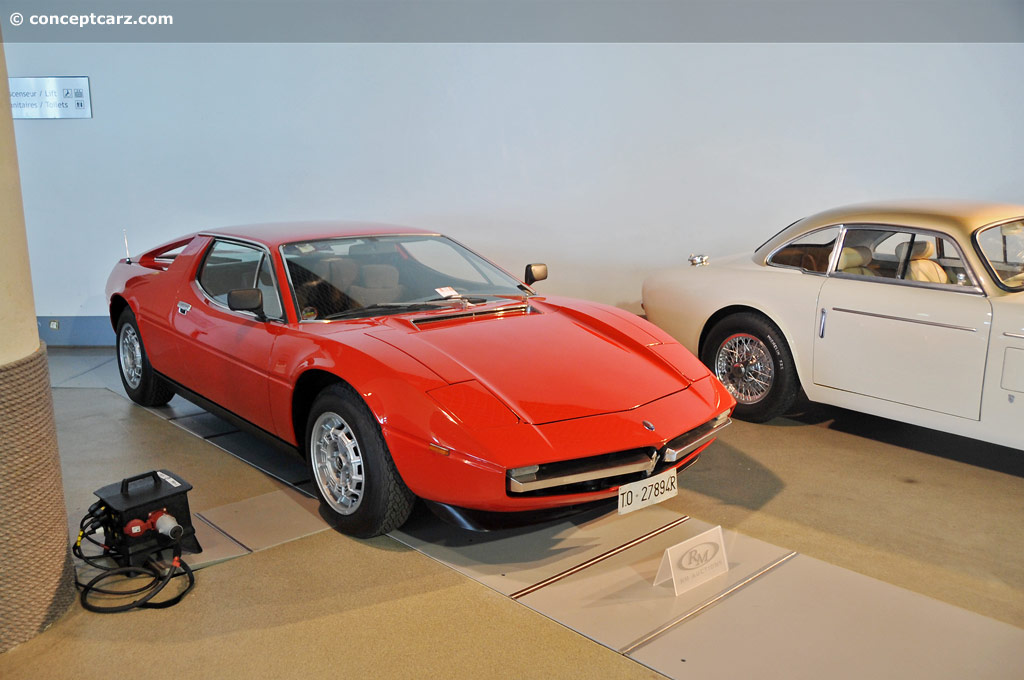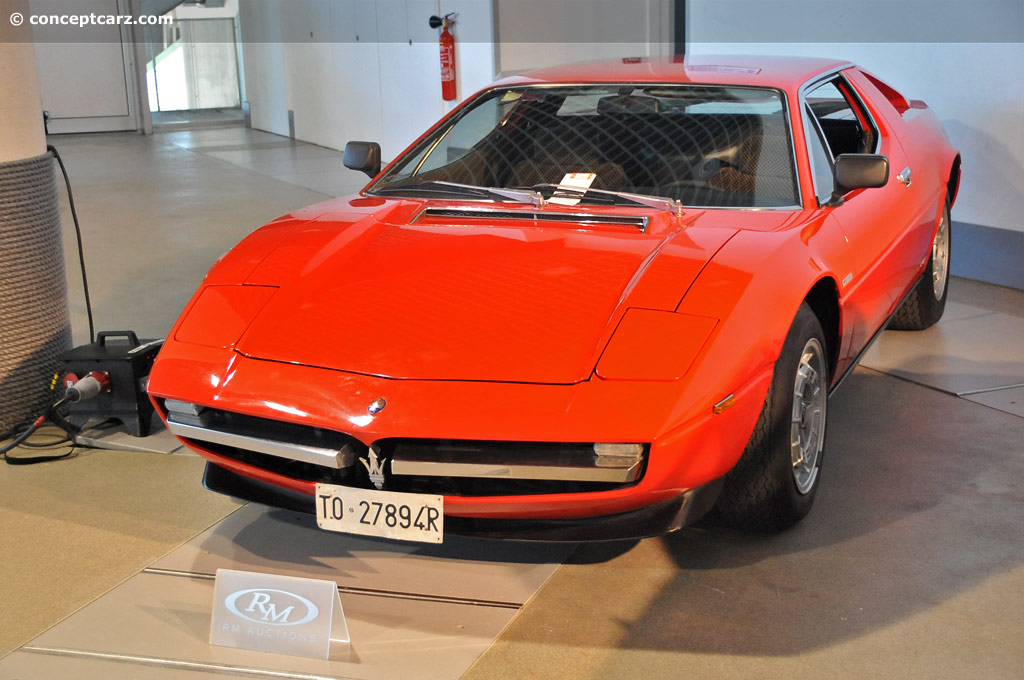When World War II came to an end and peacetime resumed, the Orsi family, which owned Maserati, resumed the company's involvement in motorsports and simultaneously built series production sports and GT cars. Racing at such venues as Monaco, Le Mans, and even Indianapolis later took a back seat as the company focused its attention on becoming a financially viable concern. By 1969, the Orsi family had sold out to Citroen, and shortly thereafter, Maserati introduced the V6-powered Merak in 1971, which shared Giorgetto Giugiaro's Italdesign styling and platform with the V-8-engined Bora. 
Coupe
Chassis #: AM1220606
View info and history
Auction entries : 1Mid-engine placement and 'junior supercar' models had grown in popularity by the 1970s, with the Ferrari 308 GT4 and the Lamborghini Urraco. Maserati's top-of-the-line exotic supercar was the Bora, with its race-bred V8 engine. Since Maserati lacked the necessary funds to develop a new model from scratch, they sent the Bora back to Giorgetto Giugiaro's drawing board, asking ItalDesign to redevelop it into something less costly to build but equally as attractive. Giugiaro replaced the Bora's expensive stainless-steel roof panel and reconfigured the glassy rear canopy engine cover with a more conventional steel lid and a pair of flying buttresses to complement the sloping roofline over the rear deck. The front part of the Bora's bodyshell, up to the doors, was shared with the Merak, with minor changes to the front end, mainly the use of dual chrome bumpers on the Merak, replacing the twin trapezoidal grilles on the Bora. The engine selected to power the Merak was the DOHC V6 powerplant Maserati had developed for Citroen in the SM. Citroen's ownership of Maserati at the time made the usage practical, cost-effective, and reduced development time. Various other components were sourced from Citroen's parts bin including the dashboard and instrument cluster (on left-hand drive cars), and the hydraulic systems. The right-hand-drive Meraks received the same dashboard as the Bora with a three-spoke steering wheel. The Citroen-sourced components had a single-spoke steering wheel and oval instrument gauges inset in a brushed metal fascia.The 2.7-liter Tipo C.114 engine was originally designed by Giulio Alfieri in 1967 for the Citroen SM. For the Merak, its bore was enlarged to 91.6mm, but the stroke remained unchanged at 75 mm, resulting in a 2,965cc (3 Liter) displacement. The chain-drive double overhead camshaft, 12-valve unit had a 90-degree angle between the cylinder banks, and the lubrication system used an oil cooler and wet sump. It had an 8.75:1 compression and used three twin-choke Weber carburetors (one 42 DCNF 31 and two 42 DCNF 32). Initially, the engine developed 187 horsepower at 6,000 RPM and 188 lb-ft of torque at 4,000 RPM. The Merak SS version had 30 additional horsepower due to three larger 44 DCNF 44 carburetors and a higher 9:1 compression ratio. The Merak 2000 GT had a 1,999cc version of the engine with 168 horsepower and 137 lb-ft of torque. This Citroen V6 engine was later modified with twin-turbochargers and used in the Maserati Biturbo and later in the 1990s Ghibli. The engine was installed longitudinally behind the passenger compartment and mated to a five-speed, synchromesh Citroën transaxle gearbox through a single-plate dry clutch and a limited-slip differential. Maserati's new junior supercar was called the Merak, after a star in the Ursa Major constellation. It made its debut at the Paris Auto Show in 1972, and remained in production through 1983, over a year after the Bora, with 1,830 examples produced. (Some sources state 1,666 examples were built, while others say 1,732). In 1976, Maserati was taken over by Alejandro de Tomaso and, by 1978, had abandoned the Citroen hydraulically-assisted brake system on the Merak and replaced it with the Bora's ZF five-speed transaxle and larger wheel and tire package. Maserati Merak SS (Tipo AM122/A)
The Merak SS was introduced in March of 1975 at the Geneva Motor Show, entering production a year later. Along with the aforementioned 30 horsepower increase, the Merak SS was 50 kg lighter. Visual changes included a black grille between the pop-up headlights, a Maserati-designed upper fascia, a four-spoke steering wheel, and round instrumentation. Later examples received the three-spoke padded steering wheel of the Maserati Bora and a redesigned dashboard. Maserati Merak SS destined for the U.S. received traditional hydraulics. Approximately 1,000 examples of the SS were built by 1983.Maserati Merak 2000GT
The Merak 2000GT was intended for the Italian market to comply with the newly introduced law that penalized cars with engine capacity exceeding 2,000cc by imposing a 38-percent Value Added Tax (VAT) against the usual 19% VAT. In November of 1977, at the Turin Auto Show, Alejandro de Tomaso introduced the 1,999cc version of the Merak - the 2000 GT. The V6 engine was de-stroked and de-bored to 80x66.3mm, respectively, resulting in 168 horsepower at 7,000 RPM and 137 lb-ft at 4,000 RPM.
Coupe
Chassis #: AM1220606
View info and history
Auction entries : 1Only two color choices were offered, including gold or metallic light blue. These two-liter cars had black bumpers instead of the usual chrome, were devoid of the front spoiler (now optional equipment), and wore a black tape stripe located just below the mid-body character line. By the time production ended in 1983, 200 examples of the Merak 2000GT had been produced. Legacy
The Maserati Merak succeeded in the goal of mimicking the Bora in regards to comfort and refinement, differing by engine size and the treatment of the engine cover. The 2+2 configuration provided occasional seating for the rear, increasing its usability. It was affordable, had a nimble and balanced chassis, attractive Giugiaro styling, and commendable driver and passenger accommodations.
by Daniel Vaughan | Oct 2020

Coupe
Chassis #: AM1220606
View info and history
Auction entries : 1
The Merak SS was introduced in March of 1975 at the Geneva Motor Show, entering production a year later. Along with the aforementioned 30 horsepower increase, the Merak SS was 50 kg lighter. Visual changes included a black grille between the pop-up headlights, a Maserati-designed upper fascia, a four-spoke steering wheel, and round instrumentation. Later examples received the three-spoke padded steering wheel of the Maserati Bora and a redesigned dashboard. Maserati Merak SS destined for the U.S. received traditional hydraulics. Approximately 1,000 examples of the SS were built by 1983.Maserati Merak 2000GT
The Merak 2000GT was intended for the Italian market to comply with the newly introduced law that penalized cars with engine capacity exceeding 2,000cc by imposing a 38-percent Value Added Tax (VAT) against the usual 19% VAT. In November of 1977, at the Turin Auto Show, Alejandro de Tomaso introduced the 1,999cc version of the Merak - the 2000 GT. The V6 engine was de-stroked and de-bored to 80x66.3mm, respectively, resulting in 168 horsepower at 7,000 RPM and 137 lb-ft at 4,000 RPM.

Coupe
Chassis #: AM1220606
View info and history
Auction entries : 1
The Maserati Merak succeeded in the goal of mimicking the Bora in regards to comfort and refinement, differing by engine size and the treatment of the engine cover. The 2+2 configuration provided occasional seating for the rear, increasing its usability. It was affordable, had a nimble and balanced chassis, attractive Giugiaro styling, and commendable driver and passenger accommodations.
by Daniel Vaughan | Oct 2020
Related Reading : Maserati Merak History
Maserati introduced the Merak at the Paris Auto Show in 1972 as a junior supercar to its larger Bora sibling. Its 22 configuration, six-cylinder engine, and mid-engine placement made it civilized, usable, and affordable compared to the Seventies crop of Italian supercars. Its styling resembled its V8-powered Bora sibling, penned by Giorgetto Giugiaros Ital Design studio in Turin, but without the....
Continue Reading >>
Continue Reading >>
Similar Automakers
Similarly Sized Vehicles
from 1979
1979 Maserati Merak SS Vehicle Profiles
Recent Vehicle Additions
Performance and Specification Comparison
Price Comparison
Merak Specification Comparison by Year
Year
Production
Wheelbase
Engine
Prices
Related Automotive News

Nissan GT-R50 By Italdesign Deliveries To Begin In Late 2020
YOKOHAMA, Japan – The first customer model of the Nissan GT-R50 by Italdesign will go on display at the Geneva Motor Show* in March, before deliveries of the limited-edition car begin in late 2020.
Before then, fans can see the prototype model...

Maserati At The 2018 Auto e Moto d’Epoca Show In Padua
Three iconic cars on display on the Maserati stand
Tipo 420M-58 – Eldorado, Merak SS and Khamsin
The Brands current range represented by the Maserati Levante S GranSport MY19
Modena, 25 October 2018 - Maserati is exhibiting at the Auto e...

1957 250 GT 'TDF' Leads More Ferrari Magic To RM Sotheby's Monaco
RM Sothebys announces extensive Ferrari consignments for Monaco sale, 12 May, covering classic through modern ages
Rare, fully matching 1957 Ferrari 250 GT Berlinetta Competizione Tour de France heads up offerings from Italian marque, joined b...

Record-Setting Bugatti Supercars Steal the Show at RM Sotheby's €23.75 Million Paris Sale
2017 Bugatti Chiron hypercar tops the lots and makes a world-record €3,323,750 at RM Sothebys 5th Paris sale
Very rare Maserati MC12 brings €2,001,875, while two-owner, highly original 1958 BMW 507 Roadster Series II rounds off the top three, se...

The Trident is Raised
One of Italys most famous marks, and perhaps most troubled, the trident-bearing automaker continues to provoke passion through its search of excellence.
Five brothers would come together in December of 1914 to found a motor company bearing their name—Maserati....

















